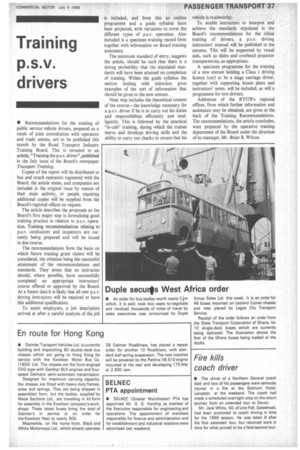Training
Page 39

If you've noticed an error in this article please click here to report it so we can fix it.
p.s.v.
drivers
• Recommendations for the training of public service vehicle drivers, prepared as a result of joint consultation with operators and trade unions, are to be published this month by the Road Transport Industry Training Board. This is revealed in an article, "Training the p.s.v. driver", published in the July issue of the Board's newspaper Transport Training.
Copies of the report will be distributed to bus and coach operators registered with the Board, the article states, and companies not included in the original issue by reason of their main activity, or people requiring additional copies will be supplied from the Board's regional offices on request.
The article describes the proposals as the Board's first major step in formalizing good training practice in relation to p.s.v. operation. Training recommendations relating to p.s.v. conductors and inspectors are currently being prepared and will be issued in due course.
The recommendations form the basis on which future training grant claims will be considered, the criterion being the successful attainment of the recommendations and standards. They stress that an instructor should, where possible, have successfully completed an appropriate instructors' course offered or approved by the Board. At a future date it is likely that all new p.s.v. driving instructors will be required to have this additional qualification.
To assist employers, a job description arrived at after a careful analysis of the job is included, and from this an outline programme and a guide syllabus have been projected, with variations to cover the different types of p.s.v. operation. Also included is a specimen training record form together with information on Board training assistance.
The minimum standard of entry, suggests the article, should be such that there is a strong probability that the 'stipulated standards will have been attained on completion of training. Within the guide syllabus the section dealing with induction gives examples of the sort of information that should be given to the new entrant.
Next step includes the theoretical content of the course—the knowledge necessary for a p.s.v. driver if he is to carry out his duties and responsibilities efficiently and intelligently. This is followed by the practical "in-cab" training, during which the trainee learns and develops driving skills and the ability to carry out checks to ensure that his vehicle is roadworthy.
To enable instructors to interpret and achieve the standards stipulated in the Board's recommendations for the initial training of drivers, a p.s.v. driving instructors' manual will be published in the autumn. This will be supported by visual aids, such as slides and overhead projector transparencies, as appropriate.
A specimen programme for the training of a new entrant holding a Class I driving licence (car) to be a stage carriage driver, together with supporting lesson plans and instructors' notes, will be included, as will a programme for non-drivers.
Addresses of the RTITB's regional offices, from which further information and assistance may be obtained, are given at the back of the Training Recommendations. The recommendations, the article concludes, were prepared by the operative training department of the Board under the direction of its manager, Mr. Brian B. Wilson.




























































































































































